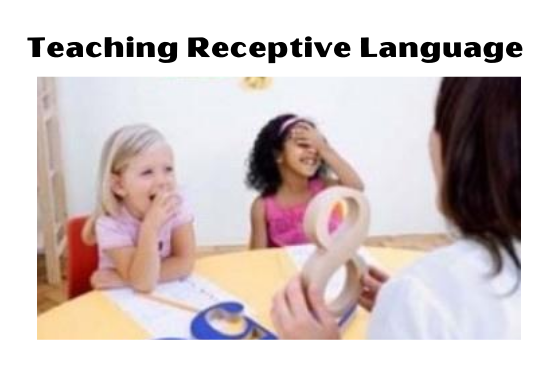Teaching Receptive Language To Children with Autism
Since the past few decades, behaviorists have been trying to find out different language teaching strategies for the children at the preschool level. Most of them concluded that teaching receptive language could be the best option for children with autism.
Almost half of the autistic children fail to develop their speech or use it functionally. Those who develop speech, their communication is less advanced than their age fellows. These children often use short sentences, inappropriate use of pronouns, idiosyncratic use of vocabulary, and limited use of proper grammatical structures. So what could be the solution? For knowing this answer, you must know the receptive language.
What is receptive language?
The individual ability to understand language and words is known as receptive language. It involves getting information and meaning from the surrounding visuals, grammar, sounds and words, concepts such as size, shape, colors, time, and other written details/information.

The children facing difficulty in spoken language, receptive language can be useful for them. They can pick up keywords and gain visual information from the gestures or pictures.
Some building blocks that are necessary to develop receptive language
To communicate successfully, receptive language is very important. But it would help if you understood some building blocks first that are useful to develop receptive language:
Pre-language skills
Pre-language skills mean the ways of communication without speaking. It includes facial expressions, gestures, eye contact, and imitation.
Attention and concentration
It means certain efforts and activities without distraction and holding that efforts to get the task done.
Social Skills
Social skills are determined by the capability to compromise with others, engage in reciprocal interaction (both non-verbal and verbal), and follow social values and norms.
Play Skills
Play skills include self-motivation activities that are linked with pleasure and enjoyment. These activities can be goal-oriented.
How to know that your child has a problem with receptive language?
Difficulties may vary depending on the child’s age. If your child is a preschooler and he/she has a problem with the receptive language, she/he might:
- Not paying attention to the tasks at the preschool level.
- Have difficulty in listening and understanding language and stories.
- Not follow the instructions that their peers would be able to follow.
- Give unexpected or unusual answers to the questions.
- Repeat the questions instead of answering directly.
Solutions to improve receptive language
- Minimal instructions: Don’t give many instructions at the same time.
- Chunk the instructions: Don’t use long sentences; chunk your verbal instructions into parts.
- Eye Contact: Maintain eye contact with the child throughout the conversation or before giving them an instruction.
- Repeat: For better understanding, ask your child to repeat the instruction (e.g., “Can you repeat that again please?”). This practice will help the child to understand what they should do.
- First/Then: Use first/then concept for making it clear for the child what order he/she needs to follow.
- Clarification: It is necessary to encourage your child to ask for clarification.
- Demonstration: When giving instructions to the child, you should physically act to show him/her what to do.
- Visual aids: Use gestures, body language, pictures, and facial expressions to assist the child.

- Describe: A preschool child, facing problem in understanding receptive language, need descriptions for everyday activities. For example: take your shoes off or put the toys in the basket.
- Word repetition: Emphasize and repeat the word you want the child to learn. Use it in different settings and situations for making it easy for the child to see its usage in different ways.
- Play: Engage the child in games and talk about how to play with the toys more productively.
- Reduce background noise: Turn off the television, music radios, or any other device that can cause noise and distraction.
- Books: Try to know which books, pictures, and stories interest the child. We recommend that a PECS book is the best thing you can buy for your child.
Activities for improving the receptive language
The following are a few activities that are useful for improving receptive language:
- Model new words: Play games that your child enjoys and model new words, phrases, and sentences throughout the games.
- Explain new concepts: Try to explain new ideas and concepts in different ways. For example, use water for explaining the concepts of wet, rain, and bath. Make different interesting stories about being wet or dry.
- Take turns: Involve your child in the conversation. While talking or giving instructions, take turns with the child.
- Feely bag game or name the item: Place everyday objects into a bag. Encourage the child to guess the item, name the items, describe its characteristics, ask about its shape and colors.
- Day to day activities: Encourage your child to talk about different situations. For example, when visiting a place or going on shopping, ask your child what did you do and saw there. You can even ask to draw or act out what happened.
- Books: PECS books are the best thing available for teaching receptive language to children. Look at the picture book with the child and ask questions about those pictures. Try to create stories with images and think about different possible ends.
There are some other activities we are providing. Visit and buy according to your child’s needs and interests.
Difficulties faced by a child with receptive language
The children facing difficulties with receptive language might also face difficulties with:
- Engaging in social interactions positively
- Forming friendships with peers
- Completing tests, exams, and other academic tasks
- Answering questions to simple questions
- Developing new skills such as reading and writing
- Following and giving directions
- Remembering new or unfamiliar places
Try to practice the activities we have discussed above. If you cannot handle the condition of your child, we will recommend you to consult a Speech Therapist.
